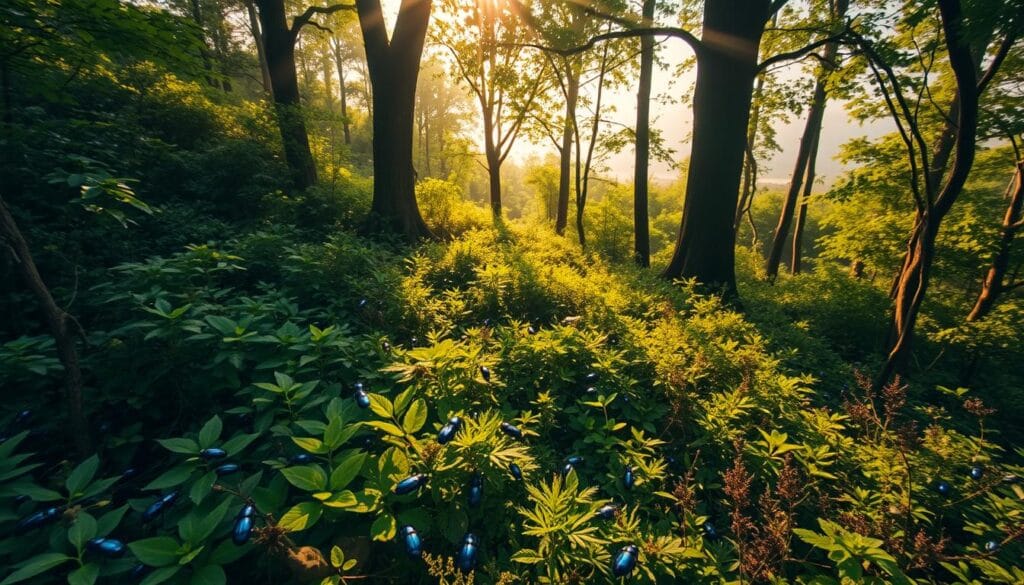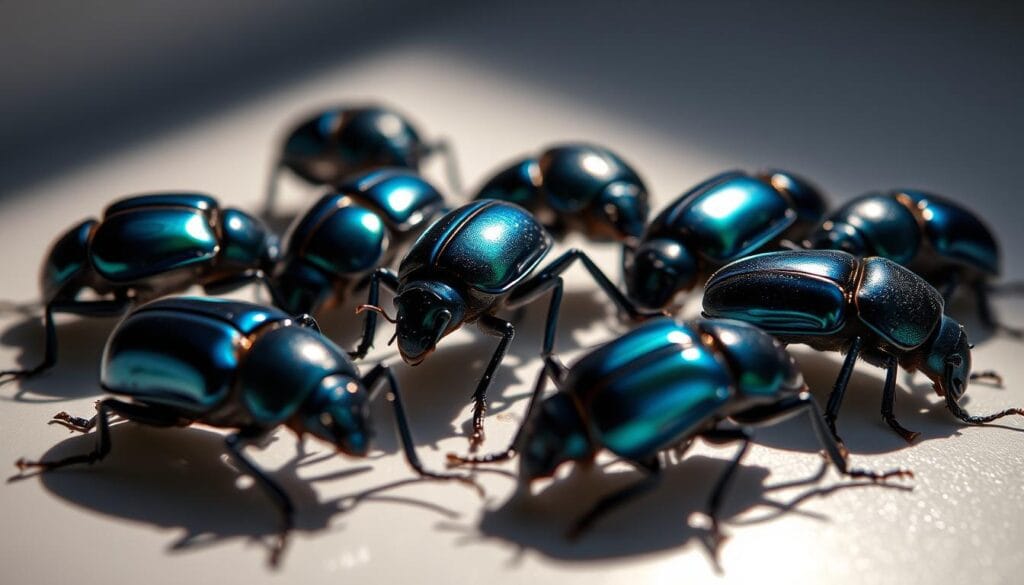Ever thought about the survival secrets of tiny desert creatures? The Blue Death Feigning Beetle has a story that will amaze you. These insects, found in the Southwestern deserts, live longer than you might think.
Picture a bug that can pretend to be dead to stay alive. It can even live up to 15 years in a safe place. These beetles are amazing because they can survive in very tough places.
These beetles are found in hot places like the Mojave and Sonoran Deserts. They also live in different parts of the United States. Their survival tricks are fascinating to scientists and nature lovers.
Table of Contents
Understanding the Blue Death Feigning Beetle
The Blue Death Feigning Beetle is a fascinating bug in the Tenebrionidae family. It catches the eye of bug lovers and scientists. These beetles live in tough places and have amazing ways to survive.
Looking into their world shows us their special traits and how they make it through tough times.
Habitat and Distribution
These beetles come from the Mojave and Sonoran Deserts. They live in very harsh places. They can be found in several states in the Southwestern United States, including:
- Arizona
- California
- New Mexico
- Nevada
Physical Characteristics
These beetles have special looks. Adult Blue Death Feigning Beetles are usually 18mm to 21mm long, with an average of about 19.5mm.
| Characteristic | Description |
|---|---|
| Color | Vibrant blue due to a protective wax layer |
| Length | 18-21mm (0.70-0.82 inches) |
| Unique Feature | Wax coating helps with moisture retention |
Diet and Feeding Habits
Blue Death Feigning Beetles have special ways to eat. They get moisture from their food, helping them live in very dry places. They should be fed 2-3 times a week. They can go a long time without eating.
Learning about these amazing bugs shows us how nature can survive in the toughest places.
Lifespan of the Blue Death Feigning Beetle
Learning about the blue death feigning beetle’s lifespan is quite interesting. These desert insects can live a long time, even in tough conditions. Their ability to survive is truly remarkable.
Average Lifespan in the Wild
In the wild, these beetles don’t live as long as they do in captivity. The Mojave and Sonoran Deserts are very hard for them. They face:
- Extreme temperature changes
- Little food
- Predators
- Stress from the environment
Factors Affecting Lifespan
Many things can change how long a blue death feigning beetle lives. Diet, where they live, and stress are important. Key factors include:
- Nutrition: A good, balanced diet
- Temperature: Keeping it between 70°F and 85°F
- Humidity: Keeping it below 20%
- Habitat quality: Clean, right living space
Lifespan in Captivity
In captivity, these beetles can live up to 15 years or more. Good care, like the right food and a clean home, helps them live longer.
The secret to their long life is caring for them like they live in the desert.
People and scientists love these beetles for living long in captivity. They are great for studying how insects can live a long time.
Life Cycle of the Blue Death Feigning Beetle
The life cycle of the Blue Death Feigning Beetle is truly fascinating. It shows how these insects change and grow. This process is a key part of how they survive and thrive.
Learning about their growth stages helps us see their amazing ability to adapt. They can handle the tough conditions of the desert.
Egg Stage: The Beginning of Life
Female beetles lay eggs in safe spots. These eggs are the start of the beetle’s life journey. They are small, pale, and hidden in soil or organic matter.
Larval Stage: Growth and Development
In the larval stage, the beetles go through big changes. Invertebrate survival strategies are clear as they adjust to their surroundings. Larvae grow, molt, and develop a hard shell, but they move slowly.
Adult Stage: Maturity and Survival
Adult Blue Death Feigning Beetles are fully grown and have unique features. They can live up to 15 years with the right care. This is very long for an insect.
Their ability to survive extreme conditions makes them true masters of adaptation in harsh desert ecosystems.
Importance of Lifespan in Conservation

The Blue Death Feigning Beetle is key to desert ecosystems. It shows amazing ways to survive that scientists and conservationists find fascinating. These insects help keep their environment in balance.
Learning about their behavior shows how they keep ecosystems healthy. Their special ways of adapting help them live in harsh desert conditions.
Critical Ecosystem Contributions
Blue Death Feigning Beetles do many important things in their home:
- Soil aeration through burrowing activities
- Breaking down organic matter
- Providing food for predatory species
- Supporting nutrient cycling in desert ecosystems
Population Challenges
These beetles face big threats:
- Habitat destruction from urban expansion
- Climate change disrupting desert ecosystems
- Increased predation due to environmental shifts
- Reduced food sources
“Preserving these tiny creatures is about maintaining the intricate web of desert life.” – Desert Ecology Research Team
Conservation Strategies
Protecting Blue Death Feigning Beetles needs a big effort. Experts suggest saving their habitats, funding research, and teaching the public. This helps these important insects.
By understanding and valuing their unique survival mechanisms, we can help ensure the continued existence of these fascinating desert inhabitants.
How to Care for Blue Death Feigning Beetles
Caring for death feigning beetles needs special knowledge and attention. These blue beetles love environments that feel like their desert homes. Knowing how to care for them is key to their health and happiness.
Ideal Habitat Conditions
To create the best home for your beetles, consider these important points:
- Enclosure size: Use a five-gallon tank for 1-2 beetles
- Substrate: 2-3 inches of dry sand
- Temperature range: 70-85°F (21-29°C)
- Humidity: Keep below 20%
Diet Recommendations
Feeding your beetles right is important. They need a mix of foods to stay healthy:
| Food Type | Frequency | Notes |
|---|---|---|
| Mealworms | 2-3 times per week | High protein source |
| Crickets | 2-3 times per week | Provides variety |
| High-protein fish food | As supplement | Nutritional boost |
Common Health Issues
Keeping your beetles healthy means avoiding common problems:
- Mold growth: Remove uneaten food promptly
- Prevent falls by ensuring secure enclosure setup
- Monitor for parasites regularly
- Maintain consistent temperature and humidity
With the right care, these amazing beetles can live up to 15 years. They make great companions for those who love beetles.
Fun Facts About Blue Death Feigning Beetles
Blue Death Feigning Beetles are fascinating insects in the desert. They have amazing survival strategies. These beetles are true masters of adaptation.
Their most interesting feature is playing dead. When threatened, they freeze for a long time. This trick makes predators think they are dead.
Unique Defense Mechanisms
Blue Death Feigning Beetles have a special survival technique. Their playing dead trick is amazing. It includes:
- Rapidly turning their bodies a vibrant blue color when threatened
- Staying completely still for minutes or even hours
- Releasing specific chemical signals that make them appear less appetizing
Cultural Significance
These beetles have caught the attention of many. Their unique behaviors fascinate scientists and nature lovers. They are a big interest in desert regions.
| Behavior | Purpose | Duration |
|---|---|---|
| Color Change | Camouflage and Deterrence | Immediate |
| Playing Dead | Predator Avoidance | Minutes to Hours |
| Chemical Signaling | Survival Strategy | Variable |
Scientific Studies
Entomologists study these amazing beetles. Their unique adaptations provide insights into evolutionary survival mechanisms. Scientists want to know how they survive in harsh deserts.
Whether you love nature or science, Blue Death Feigning Beetles are fascinating. They show us the incredible world of insect survival.
Observing Blue Death Feigning Beetles in Nature
Exploring the world of blue beetles needs patience and sharp eyes. Blue Death Feigning Beetles show amazing behavior in the desert.
To see these insects, know where and when to look. They live in certain areas with special conditions.
Best Locations for Sightings
For the best chance to see Blue Death Feigning Beetles, check these places:
- Mojave Desert regions in California
- Sonoran Desert areas of Arizona
- New Mexico’s arid landscapes
- Western Texas desert territories
Optimal Times for Observation
These beetles are active during the day. They move most in:
- Mid-morning (8:00 AM – 11:00 AM)
- Late afternoon (4:00 PM – 6:00 PM)
Seasons change how beetles act. Spring and early summer are the best times to see them.
| Region | Peak Observation Season | Recommended Time |
|---|---|---|
| Mojave Desert | March – June | 9:00 AM |
| Sonoran Desert | April – July | 5:00 PM |
Always respect their home and keep a distance. Binoculars help you watch these desert wonders without disturbing them.
The Role of Blue Death Feigning Beetles in Research

Blue Death Feigning Beetles are fascinating in scientific research. They give us insights into how invertebrates survive and live long lives. These beetles help us learn about complex biological adaptations in tough environments.
Scientists are really interested in these beetles because of their amazing desert survival skills. They want to study how these beetles can survive in harsh conditions.
Areas of Study
Entomologists study Blue Death Feigning Beetles in several important areas:
- Desert ecosystem adaptation mechanisms
- Unique defense strategies in invertebrate species
- Physiological responses to extreme temperatures
- Insect longevity in challenging environments
Importance in Education
These beetles are great for teaching complex biological concepts. They help students and researchers learn about:
- Ecological resilience
- Survival strategies in extreme habitats
- Invertebrate behavioral adaptations
Contributions to Entomology
Blue Death Feigning Beetles have greatly helped entomology research. They show us how to survive in extreme temperatures and go without food for a long time. This makes them very important to study.
Their remarkable adaptations continue to challenge our understanding of insect survival strategies.
Conclusion: Appreciating Lifespan and Legacy
The Blue Death Feigning Beetle’s life journey is a marvel of nature’s design. It shows how the Tenebrionidae family is full of survival and adaptation stories. These stories go beyond just living.
Exploring these insects, you’ll see how they can thrive in tough places. They can live up to 5 to 8 years in captivity. This shows their amazing resilience. Scientists and fans can learn a lot from their survival tricks, like pretending to be dead.
These beetles are important for our planet. They play a big role in desert ecosystems and help in scientific studies. If you’re into unique pets, they might inspire you to look at different options that break the mold.
The blue death feigning beetle’s lifespan is a sign of nature’s complexity. It shows how even the smallest creatures can survive and thrive.

